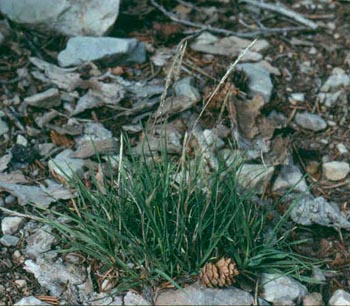Letterman's Needlegrass

Common Name(s):
Letterman's Needlegrass
Scientific Name:
Achnatherum lettermanii (Vasey) Barkworth
Stipa lettermanii Vasey
Symbol:
ACLE9
Description:
Life Span: Perennial
Origin: Native
Season: Cool
Growth Characteristics: Letterman's needlegrass is a native, densely tufted, slender, perennial bunchgrass which often forms large clumps. This fine-stemmed, cool-season, erect grass grows from 6-60 inches (15-150 cm) in height. It has a fibrous root system. Height ranges from 12-24 inches tall and it reproduces primarily by seed, but also by tillering. Roots are fibrous. Flowers from July to September.
Seedhead: Panicle is slender, loose and pale green. It is spikelike and 3-8 inches long; spikelets are ¼-½ inch long; glumes are prominently nerved on back, 3-7 mm long; awn is twice bent 1.5-4.5 cm long; callus is blunt; lemmas are hairy along the apex, 4-5mm long; palea ¾ the length of lemma.
Leaves: Mostly basal, very fine and tightly rolled, 2-8 inches long; sheaths open; auricles absent; ligules membranous.
Stems: Slender, smooth, 12-24 inches tall.
Ecological Adaptions:
Letterman needlegrass occurs across a wide range of elevations and exposures, and is found in mountain valleys, rocky ridges, open coniferous forests and aspen woodlands. Elevation ranges from 5000-11700 feet in areas that receive 16-20 inches of precipitation. This species begins growth early in the year and remains green throughout the season. It is considered to be more drought tolerant than Columbia needlegrass. It is susceptible to fire when burned during mid-summer.
Soils: Sandy loam, loam, silty clay loam, or clay loam. It typically occurs on dry soils 15 inches (38 cm) or more in depth, but it can be found on very fertile soils or severely eroded ones
Associated Species: Sandberg bluegrass, aspen, locoweed, sagebrush
Uses and Management:
Letterman's needlegrass provides valuable forage for many species of wildlife and domestic livestock. It is consumed by mule deer, white-tailed jackrabbits, and northern pocket gopher. This species begins growth early in the year and, like most needlegrasses, remains green throughout a relatively long growing season. This pattern of development enables animals to use Letterman's needlegrass when many other grasses are unavailable. It is grazed in early spring before fruits have developed as it becomes less palatable when mature. It is usually grazed in the fall only if the fruits are softened by rain.
Letterman's needlegrass is palatable to many species of wildlife and livestock. It is generally most palatable early in the season before the foliage becomes coarse and wiry. The awns and/or calluses of many needlegrass species become sharply pointed at maturity, causing grazing animals to avoid them after they mature. These sharp plant parts can injure livestock, but such injuries have not been well documented for Letterman's needlegrass. In Utah, Letterman's needlegrass is considered a fair to good cattle forage but relatively poor domestic sheep forage.
Letterman's needlegrass provides some cover for small birds and mammals. On Utah ranges, Letterman's needlegrass tends to increase in response to heavy grazing by domestic sheep. It apparently decreases in response to light cattle and horse grazing. In the absence of grazing, Letterman's needlegrass competes poorly with such species as Kentucky bluegrass and Thurber fescue.
This species has been used in revegetating mine spoils in Idaho.

